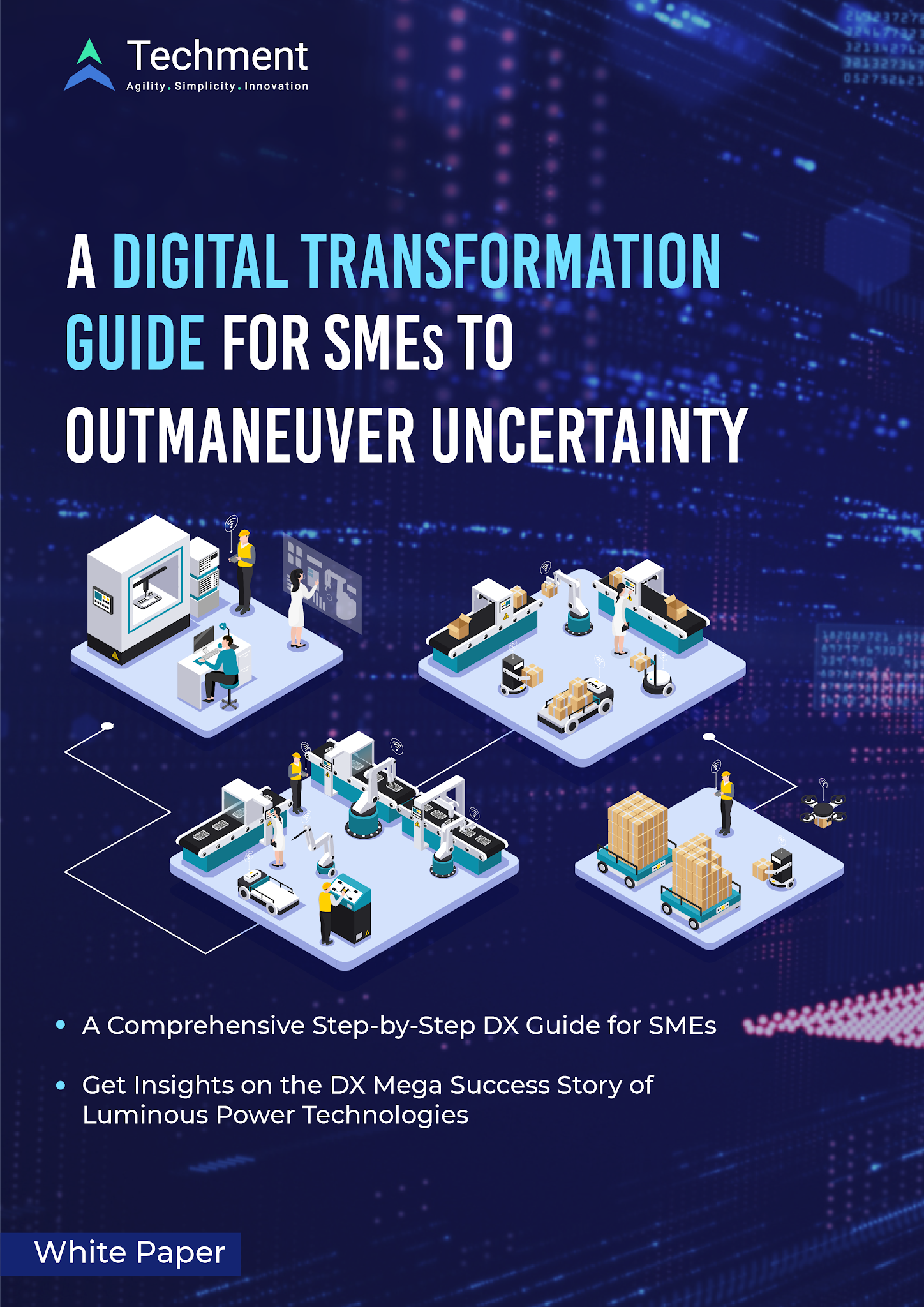
Table of Content
-
Understanding Digital & Digital Transformation
-
Step A: Digital Maturity Assessment
Techment Digital Maturity Model
Step B: Rethink, Refine and Redefine Your DX Vision
Step C: Requirement Assessment for Technology and Upskilling
Step D: Ensure Sustainability with Cultural Initiatives
Step E: Craft the Digital Strategy
Techment Digital Strategic Quadrant
DX Enables Business Transformations
Step H: Digital Transformation
Synchronize Digitalization with Business Goals
Reconceive Value Chain vis-a-vis New Customer Expectations
Drive Business Decision With Data
Executive Summary
If there were sacrosanct boundaries separating that which can and cannot be gobbled up by the 0s and 1s, there certainly are none such today. Disruption has forced the hands of CXOs to initiate digital transformation as an imperative response to the all-pervasive change.
This exigency puts further pressure on DX success rates, which have historically been low. Yet, the SMEs with the right DX strategy and an able technology partner can leverage their agility (organizational as well as cultural), lack of legacy systems, and affordability of new technologies to rewrite the history of successful transformations.
On the other hand, the inherent complexity and subjectivity in the process make it easy to get lost and fail to leverage the digital. Therefore, through this guide, we have endeavored to give a comprehensive digital transformation framework to SMEs, covering every critical aspect of the journey with insights from the world's most influential thought leaders. We hope that this guide helps SMEs succeed in their digital transformation journey.
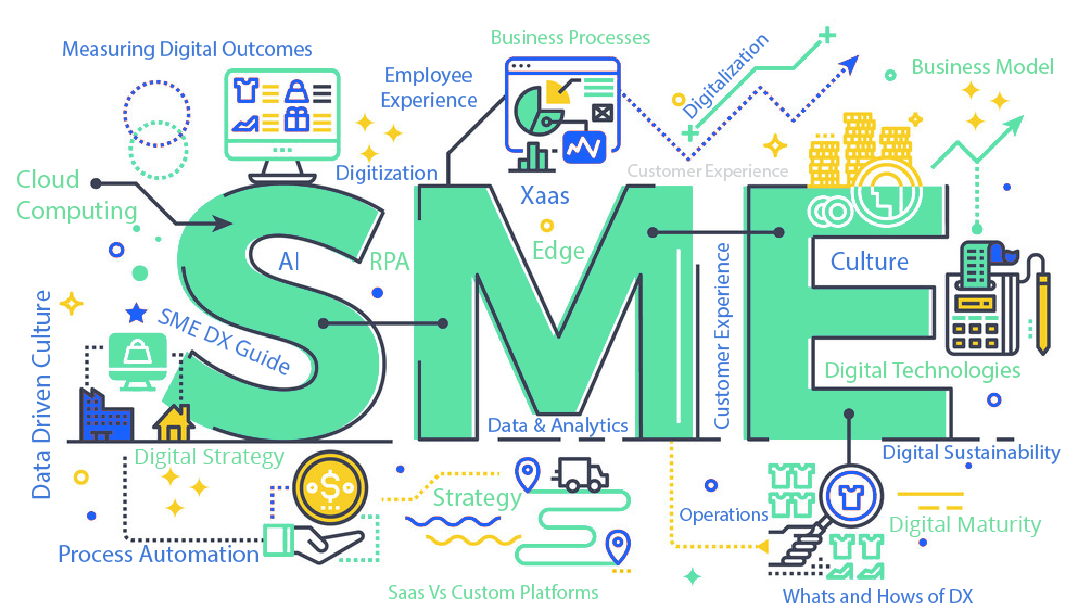
The Great Digital Migration
Our Esteemed Collaborators
We thank each of the following experts who were interviewed for this paper. Our heart-felt gratitude towards them for giving their precious time and invaluable insights that have added immense value to the paper.
Antonio Grasso is the founder & CEO of Digital Business Innovation Srl. Antonio is a celebrated DX influencer, a global startup mentor, global Juror for the United Nations’ SDGs, and more.
Rajiv Ganju is the Sr. Vice President, Global Supply Chain at Luminous Power Technologies (P) Ltd. Rajiv is a versatile leader who won various awards such as IDC awards 2017 for best digitization practices followed in manufacturing; "The Great Manager Award" by Times Ascent and People Business, 2016, and more.
Safir Adeni, Chair, Forbes Business Council Dallas. Safir is the world's leading DX expert, an experienced transformation leader with a rich history of successful business turnarounds, and a sought after CX strategist.
Nirupam Srivastava is the Vice President - Strategy and AI, Hero Enterprise. Nirupam is a charismatic leader with extensive experience in leading Corporate and Business Strategy, Mergers and Acquisitions, Digital Transformation, and more. He has been in leadership positions at IBM, Schneider Electric, and Essel Group.
Introduction
If you are reading this white paper from a remote location, the pandemic has certainly lingered on long enough to have an enduring influence on human life. Incapacitated by the constraints of the physical, 2020 has seen firms from all walks of life gasping for the digital. Ironically, even though over 50%1 tech investments in information and communications technology (ICT) would be
towards Digital Transformation (DX) and that companies spent around $2 trillion on DX in 2019, it remains an enigma.
What makes DX hard to comprehend and highly subjective? Why are the last mile challenges so formidable? Through this digital transformation guide, we have tried to unravel this phenomenon for Small and Medium Enterprises (SMEs).
The Impact and The Aftermath
The pandemic has triggered an exodus of companies to the digital. Its impact on businesses has been on these four crucial fronts:
-
Rapid and continual change in customer behavior and needs
-
Demand unpredictability
-
Erosion of old channels of service and product delivery
-
Remote workforce
The cumulative effect of these changes have been monumental:
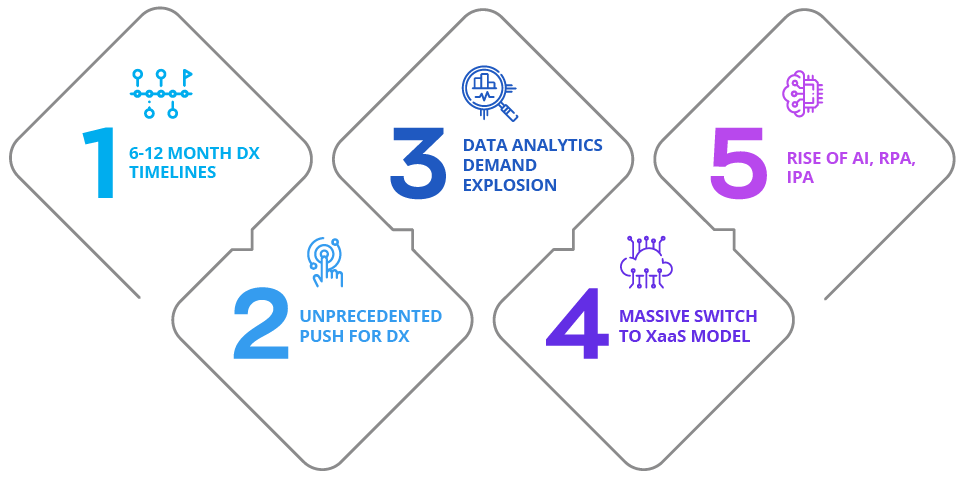
The Cumulative Effect
-
Timelines to go digital have shrunk from 4-5 years to just 6-12 months.
-
Unprecedented Quantum of Change: Like many other sectors, US e-commerce saw its penetration rise by 17%, to reach 33% in just two months!
-
Telehealth usage has skyrocketed, and the industry has become more tech-hungry.
-
Data and Analytics Demand Exploded: The pandemic has everyone trying hard to drive business insights from data.
-
Conversational AI, RPA, and IPA are seeing an astronomical rise in their demand and will keep gaining momentum and SMEs have a lot to gain out of these game-changing technologies
-
Exodus to Digital: The world is switching to XaaS model, i.e., Everything as a Service, and no company wants to miss out.
The world is switching to XaaS model,
i.e. Everything as Service.
Look Before you Leap!
All bad technology decisions are made in good times, i.e., during peak economic growth, companies overinvest. Using technology to scale is the right choice, but, as one bank demonstrated, mindless overinvestment is catastrophic. The bank ended up with 22 CRMs, who didn’t talk to each other, and their retail banking system did not communicate with the corporate banking, and so on.
Their example illustrates that it is easy to get carried away with all the adrenaline and hullabaloo about the omnipotence of digital; SMEs must exercise caution.
The other and more damaging mistake an SME can make is- not to invest in the IT or digital capabilities during recessionary times. (Investment During Recession- Explore more)
Digital Will Confound Your Plans
Most organizations fail to understand the peculiarity of digital that it disrupts by confounding spreadsheet plans, creating more value for the customers than for the companies. It is one of the dozens of frontiers where companies are wanting in realization. They may not fully realize the momentum of digitization, the technologies that are driving it, or the behavioral changes necessary for survival. Are you locked up in an annual strategy development cycle when it should be weekly or monthly?
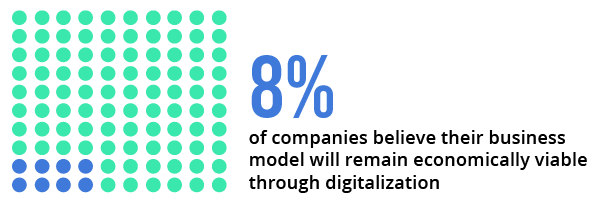
In a 2018 survey by McKinsey Global Institute, only 8% of the respondents said that their current business model will remain economically viable, given the pace of disruption. Well, that was 2018, today there is greater realization, and the need to change has never been so glaring. Yet, the whats and hows of DX remain elusive!
In this guide, we take you through the entire journey, step by step.
Understanding Digital & Digital Transformation
According to IDC, about 50% of business revenues are expected to be influenced by digital in 2020, underscoring its significance.
Paradoxically, for an issue of such import, only around 7%2 of organizations across the globe understand what digitalization entails!
From the Expert: What Digital Entails?

Antonio Grasso, a celebrated global DX influencer, founder & CEO of Digital Business Innovation Srl, in a detailed interview with Techment Technology shared his thoughts around the digital. Here are the excerpts from the interview:
"To many, going digital is more about technology; to others, it is a novel way of reaching out to customers, and for many others, it is an entirely new way of doing business. Though all of these are correct ways of expressing the digital, such divergent perspectives are bound to create misguided endeavors and inchoate visions that will eventually lead to lackluster performances and unnecessary complications.
Unsurprisingly, the success rate of digital transformation is just one-third!"
Mr. Grasso explains that “At the heart of a digital organization is the "customer". In quintessence, to be digital is to have the complete picture of customer behavior (inside as well as outside of the business), and having the agility to respond to trends as they evolve. A digital organization is intimately attuned to its customers and their decision process, and its continuous evolution.”
The shift to the digital is an epochal change and one
in which managing cultural resistance would be paramount.
-Antonio Grasso
Antonio sees the digital as a powerful tool that must be used collaboratively. Institutions across the world must share digital capabilities and assets such as data to fight the common evils such as the pandemic and climate change.
Defining Digital Transformation
Digital transformation is about incorporating digital technology into various aspects of a business, the more, the merrier. It brings about a fundamental change in operations, and business processes to unlock a large amount of value. Digital in-return demands a shift to an agile and data-driven culture that is comfortable with challenging the status quo and experimentation.
Exploring the Elements of DX
Antonio Grasso sees DX as a journey, not a destination. Though each transformation is unique and serves a specific set of goals, any organization looking to evolve, scale, or improve business digitally, is making changes in these seven elements: Business Processes, Operations, Business Model, Strategy, Customer Experience, Employee Experience, and Culture.
Antonio adds that “SMEs, given their scarce resources, can only transform a few elements of Digital Transformation, but in this journey, they must continually attempt to transform most elements that make a digital organization. Bolder approaches to DX have proved to be remarkably more successful than timid ones.”
Techment’s DX Framework
Given the inherent subjectivity of the process, we have devised a framework that gives a definitestep-by-step process for a systematic and clear approach to DX.
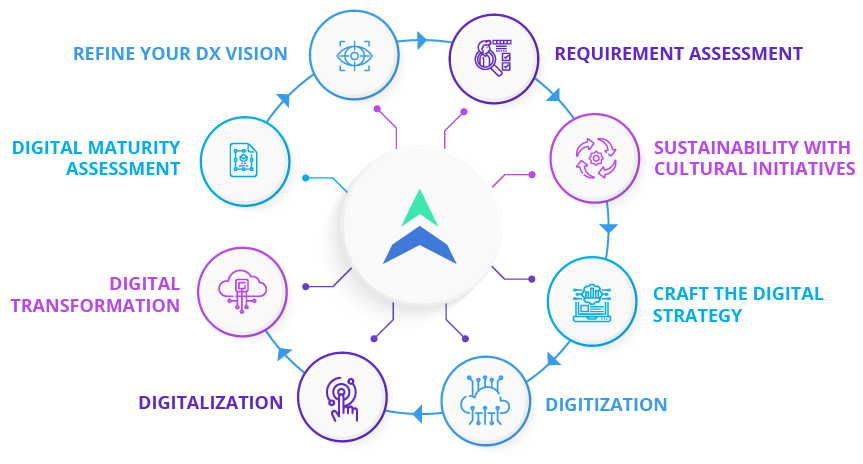
Techment’s DX Framework
A. The First Step to DX: Digital Maturity Assessment
Well begun is half done! It is crucial for the success of the entire enterprise that the first step is in the right direction.
Techment’s Digital Maturity Model
Understanding the digital status quo is essential as each company stands at a unique stage of Digital maturity, and its assessment is the first step of the transformative journey. To facilitate a quick and easy assessment of digital maturity, we devised this model.
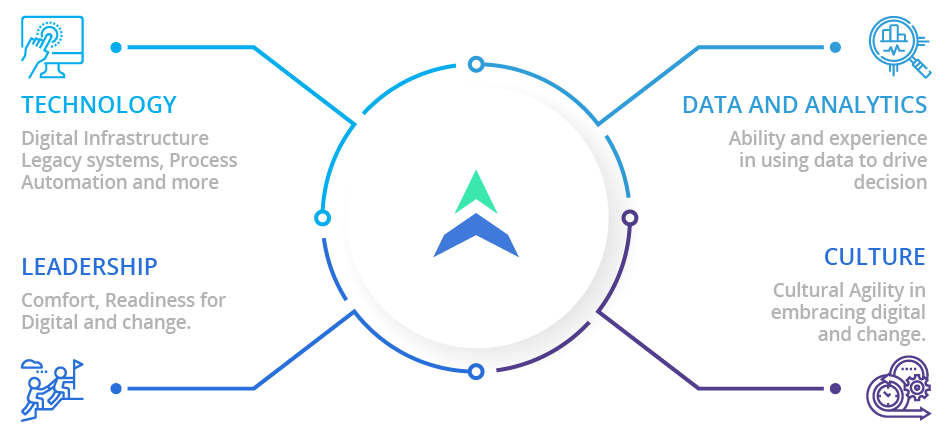
Techment’s Digital Maturity Model
It highlights the foundational pillars of digital maturity. Maturity in each element is essential, as digital maturity in one area would augment maturity in the other. You can do a self-assessment, (or take the help of your tech-partner) by reflecting on the below questions for each element of digital maturity.
-
Leadership Readiness Assessment
Is your leadership ready for digitization; are they comfortable with incorporation of new technologies, and rapid change at the foundation of the company? -
People, Culture and Mindset Assessment
Are the people in your company eager for the digital, for data, and agile mindset? If they feel that change is an imposition, it is essential to address it with new initiatives and exposure. -
Technology Capability Assessment
Where does your digital infrastructure stand vis-a-vis your peers and leaders?
Legacy systems can hold you back, establish their relevance, speak with experts.
Are your methods of storing and collecting data in line with contemporary ways such as edge and cloud?
Broader, organization-wide scope of data collection is a sign of maturity. How wide is yours?
Processes automation improves digital maturity, are your principal processes automated? Digitally mature companies use digital to improve customer experience; how extensively do you?
Do you use digital to enhance employee experience?
Data and Analytics
Driving your decision from data, use of diverse channels to reach customers, using digital to innovate, are all the signs of a digitally mature company, though the extent would vary for each company. Realizing tangible benefits takes time; begin early.
The results of the above assessment exercise puts you in one of the four quadrants of “Techment’s Digital Maturity Matrix”.
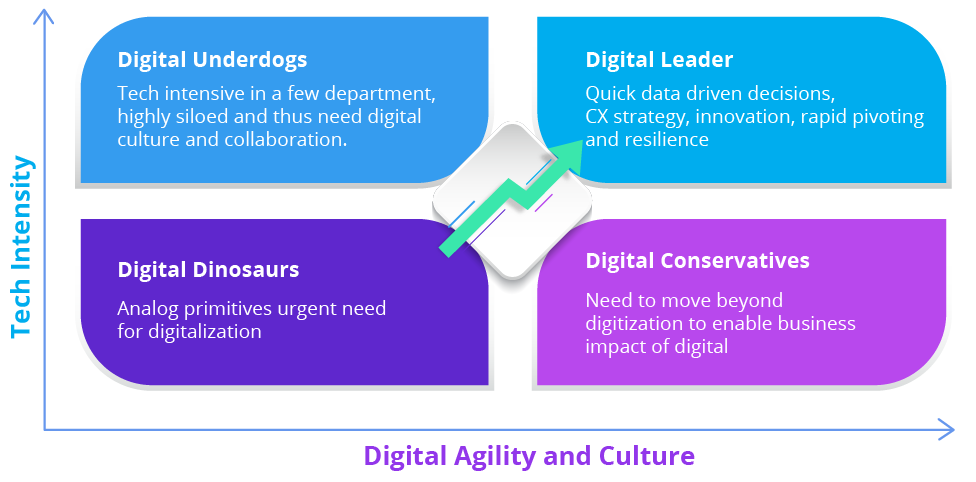
Techment’s Digital Maturity Matrix
Digital Dinosaurs: A company which is yet to digitize any aspect of its organization, and has a primitive mindset of conducting business. Strategic Imperative: They must embark on digitizing their operations immediately.
Digital Underdogs: There are companies who have extensively digitalized a few of their departments or sections but silos and myopic approach prevents them in leveraging digital significantly. Strategic Imperative: Expand the scope of digitization to most departments and break silos though interconnection and collaboration.
Digital Conservatives: These are early, and cautious adopters who have incorporated the lowest hanging fruits of digital, like digitization and basic automation. Strategic Imperative: They are most suited in leveraging the digital capabilities as the foundation is there. Technology can rapidly transform the business.
Digital Leaders: They are the ones exemplifying the meaning of digital. Strategic Imperative: They must keep using technology to lead in the industry 4.0 ecosystem
As a company, when you identify your location in Techment’s Digital Maturity Matrix, it opens up the strategic pathway to move forward. Once the company understands its digital maturity, it can devise a digital strategy more confidently.
B. Rethink, Refine and Redefine Your DX Vision
There is so much you want to do, but where should you put your energies into placing game-changing bets or remaking the existing legacy systems? Or both? Some view DX as upgrading their IT function. Others focus on digital marketing or sales. But very few have a broad, holistic view of what digital means.
Lacking a clear definition of digital, companies struggle to connect digital strategy to their business goals, leaving them adrift in the fast-churning waters of digital adoption and change.
Having completed the analysis of digital maturity, it is time to further refine the DX vision by asking the following questions.
-
Revisit Digital’s Economic Impact
Contrary to common aspirations to use digital for economic advantage, the digital will unbundle your product, allowing customers to pick what they need. Intermediaries would become obsolete, and consumer choices become limitless with price transparency. Digital always shifts an ill-proportionately large value to customers and you have to reassess your value proposition as it is a different ball game altogether. -
Redefine Your DX Goal
Research reveals that the top benefits of DX are improved operational efficiency, faster time to market, and better customer experience (CX). Should you focus on digitization of core operations or go for digital innovation, understanding your digital maturity and your industry will help. You may want to go for both, but keep your priorities straight and avoid a siloed approach. -
Choose Clear Objectives with Unwavering Focus
New or current business model? CX or cost efficiency? Enhancing innovation or productivity?
-
Set Bolder and Wider scope
Enterprise-wide digital and analytics transformations are about 1.5 times more probable to be successful. The scale and scope make them more likely to create new digital businesses during their transformations. Being risk-averse and too siloed prevents digital aspirants from realizing business impact from their digital activities. -
Rethink Your Siloed Approach
A cohesive approach that reconciles strategy and execution has become a necessity as the feedback from execution helps reshape the strategy. Digital demands agility; you need to synchronize both simultaneously and iteratively to succeed.
Choose any one, but link them to performance goals. Cultivate a sense of shared accountability to make DX successful.
Before the massive enterprise sets in motion, reflection on the above might help find the right direction.
C. Requirement Assessment for Technology and Upskilling
Your vision lays down the path for your new team with new skills.
In 2018, there were about 500,0003 unfilled tech jobs in the USA, highlighting the fact that companies can not hire and get what they want. Upskilling has become highly crucial in the digital age.
One way is to encourage innovation from every corner, as the team would realize technology requirements, they would also become aware of the new skills needed to support ideas and business growth. Invest in training and cultural orientation, as it would lead to upskilling as well as better employee retention.
D. Ensure Sustainability with Cultural Initiatives
One McKinsey survey finds that only 16% feel
that the DX resulted in improved performance
with long term sustainability. What’s more,
only 3 percent report complete success at
sustaining their change.
Of the 70% transformations that fail, the dominant
reason is employee resistance.
In other words, the success of DX depends upon its people, and the best way to get them moving is to make them in charge of innovation and change. The battle cry of DX would then be heard from people’s side and not from management.
Entrust your teams to bring forth innovation and change and in finding the best possible way to achieve it.

Cultivate an attitude of thinking in terms of sustainability.
E. Craft the Digital Strategy

In the unchartered waters of global chaos, uncertainty runs rife. A prudent digital strategy is one powerful tool that can help SMEs find an anchor to navigate turbulence.
Safir Adeni, Chair, Forbes Business Council Dallas, and world’s leading DX expert, in an interview with Techment Technology, spoke on the most significant pillar of DX, the digital strategy. Here are the excerpts from the interview.
“Given their limited budget and resources, SMEs must focus on augmenting Customer Experience (CX) as it culminates in higher customer loyalty, retention, better Net Promoter scores, and profitability as customers are willing to pay more for the “WOW” experience.”
On the question of technology strategy, SMEs must incorporate digital technologies that help them gain insights into the “what” and “how” of customer experience, as well as, those that enable cutting-edge CX.
Incorporation of advanced technologies like RPA, NLP, AI, ML, blockchain won’t just improve the cost-efficiency of an SME, they prove instrumental in creating a competitive advantage by improving the CX, resulting in seamless market scalability and enhanced profitability. SMEs must explore affordable ways to experiment with these technologies.
On the issue of data strategy, SMEs must focus on limited data, out of which they can draw meaningful insights. They must focus on the quality of data vis-a-vis quantity as bad data, especially for SMEs, would only breed mistrust in data.
Bold strategies for digital transformation are significantly more successful. The reason may lie in the fact that bold strategies result in leapfrog technology advancements, and strong market differentiation.
The overall approach to DX for SMEs must be Balanced by Design.
This approach has the advantage of ensuring optimal transformation
as leaders cherry-pick quantum leaps as well as incremental ones.
-Safir Adeni
Techment’s Digital Strategy Quadrant
We have devised a strategic quadrant that makes it easy for the firms to identify and define their approach to Digital Transformation.
If your company finds itself in Quadrant 3 and 4, partial and timid moves to transform business might not bring success. Especially firms in Q4 can be companies in Healthcare, E-commerce, Entertainment, and more need to make bold moves to make the best out of the situation. Similarly, companies in Q3 have the challenge of balancing the digital twins; they must transform their present business model and also work on a new business model. They can be companies in the agriculture, food, manufacturing, energy sector, and more. The change may not be as fast, but it is surely catching up. Companies must decide their strategy based upon which quadrant they lie in!
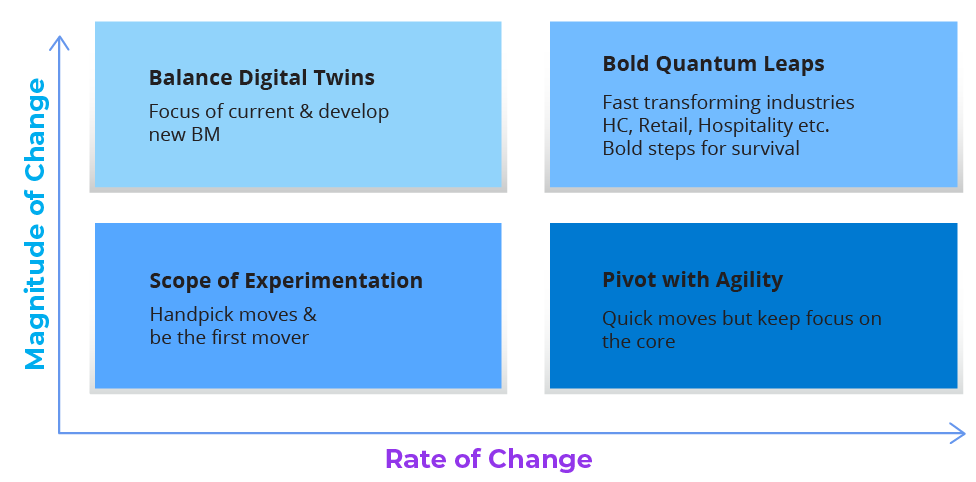
Techment’s Digital Strategy Quadrant
DX Enables Business Transformations

Today, the Avalanche of change is seen more often, and to succeed at every disruptive turn, organizations need to transform their business. Each successful transformation, though unique in itself, has lessons for many. These lessons can guide companies in their DX journey.
Isabel Velarde, Founder & CEO, of Innovation Hub Consulting®, who works with innovative companies, spoke to Techment on the best practices she has observed in successfully digital and innovative companies. Here are the excerpts from the interview.
“Business transformation involves an articulated series of changes, but the first step is to recognize the need for change. Successful transformations are guided by a comprehensive framework that encompasses reengineering in business processes, adoption of new technologies, a change in the corporate culture, and the incorporation of a change management strategy.
More often, successful Business Transformation involves a change in the Core Business and aligning processes, people, and technology to better match the overall business strategy and vision for the future. In the transformation process, innovation is an essential element and must get a boost from new digital capabilities the company has acquired. Without the enhancement of innovative capabilities, transformation is incomplete.“
Business transformation is a fundamental change, and only digital companies that are hyper-agile will have the capabilities to undergo rapid transformation within a relevant timeframe. Digital transformation becomes a vital piece of the process and the puzzle.
The Great Digital Migration
You are now equipped to initiate change in your organization. But before we go into the actual process, let us understand the terms used so often and understood sparingly.
In terms of conspicuous change, the process has three steps:
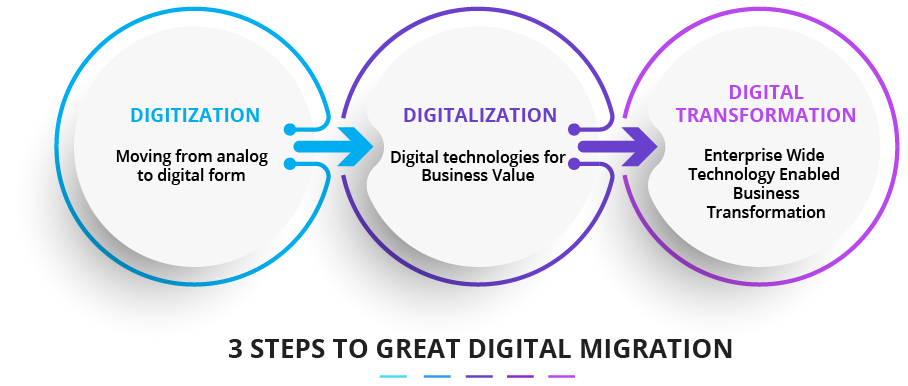
1. Digitization: Digitization is the process of moving from analog to digital form
2. Digitalization: It is the use of digital technologies to change a business model and provide new revenue and value-producing opportunities,” according to Gartner’s glossary. To put it in another way- Digitalization is the process of employing digital technologies and information to transform business operations.
3. Digital Transformation: Do not make the grave mistake of confusing digitalization as being similar to DX. It is a customer-centric business transformation that requires radical organizational change and the incorporation of digital technologies
A digital transformation project will involve several digitization projects and involves significant levels of change management.
F. Digitization

Data is the blood of modern era organizations.
Organizations such as SMEs must develop the
requisite infrastructure and processes to handle
the data, filter, and store it.
Planning and installation for adequate infrastructure
to record, store, and transfer data, as well as
training the support staff, are essential for
smooth functioning.
Amit Chatterjee, the Industrial IoT Segment Leader and Strategic Business Development, Intel Corporation, shared his insights and recommendations with Techment Technology. Here are the interview excerpts:
On account of scarce resources, tech investments have to be very prudent. For many SMEs, proper digitization of processes would be a challenge as it comes with infrastructure cost, support staff expenditure, maintenance, and other costs. Though the cumulative cost of the system, the cost connectivity, IT team, security, and surveillance prove to be financially heavy, they have to make allowances as digitization to survive. Today, even small enterprises without an IT team need to focus on digitization; they can address the challenge by training their team to manage the IT systems.
For SMEs, the value gain from digitization is immense because it allows them to monitor and control their processes at the micro-level, and improvement comes only after the ability to record and measure.
Initial success for SMEs would be to ensure traceability and visibility of their products and processes; it is the first step to efficiency improvements. Automated ticketing systems can help them monitor without errors and at lower costs.
Second, the quality benefits are also significant, as better control and production data can help companies get quality certificates to become certified suppliers to big brands. Digital helps in monitoring failure rates that help in inventory management at daily, weekly and monthly levels.
Third, lot rejection cost due to inspection is very high. Thus quality control enabled with digitization is a lifesaver. IoT can help in many ways, even for small enterprises with inventory tracking, route management, predictive maintenance, and more.
One vital digitization step would be to incorporate enterprise-wide EPR and must be open to incorporating RPA, AI for easy scalability, and efficiency gains. For smaller companies, the cloud is the best solution, and based on data rate, they should decide between cloud and edge.
G. Digitalization

Nirupam Srivastava, Vice President - Strategy and AI, Hero Enterprise, spoke at length with Techment on the most significant issue of digitalization and how SMEs can use it to succeed in the digital age.
“SMEs being short on budget, team, and resources need to prioritize. Focus on leveraging digital for differentiation and competitive advantage might be the best bet as they cannot compete on cost for lack of scale. The greatest strength of an SME is its agility, and by digitalization, they have the opportunity to turn it into a competitive advantage.
Customer Experience is the most vital area they can make a difference.
They should pursue digitalization with a focus on improving customer intimacy, cycle time, as well as, to enhance personalization.
SaaS Vs. Custom Platforms
SaaS comes with an inherent advantage that it is
readily deployable and saves a lot of time, and
can be subscribed for a shorter duration, facilitating
experimentation which can be vital for Startups/
New initiatives.
Mr. Srivastava adds that for companies who know
what they want, custom build platforms can serve
better because no company would want to shift to
custom platforms after three years, if it can be
done today. The benefit of custom platforms is
that they are tailored to your business and can be
tweaked to facilitate the changes. There is no one
right answer, a thoughtful analysis is indispensable.
Digitalization is the process of moving towards a digital business by implementing
digital technologies to transform
business models, customer services,
product offerings,
operations, customer engagement, and more.
- Nirupam Srivastava
H. Digital Transformation (DX)
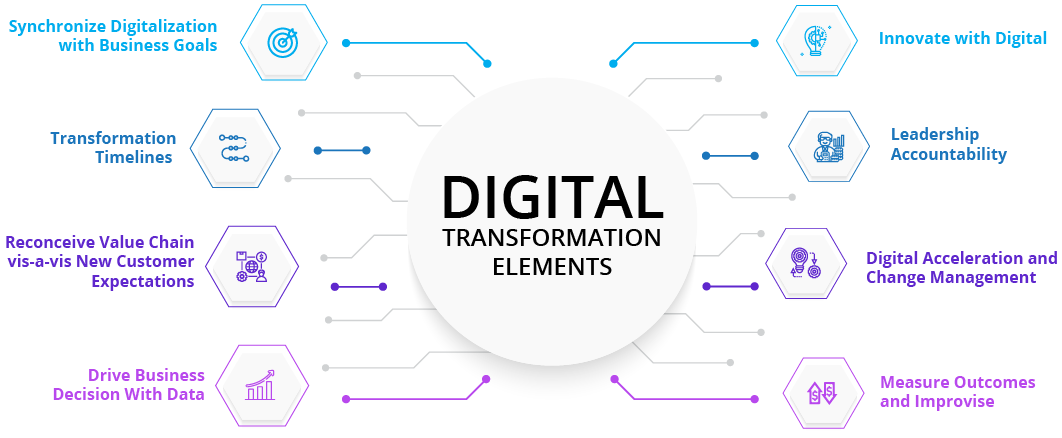
Techment’s Digital Transformation (DX)
Leadership and change management are an integral part DX as it is a journey of continuous digitalization and change. Here are the elements that you must consider while transforming.
Synchronize Digital Transformation (DX) with
Business Goals
Mr. Srivastava prescribes that “With each initiative,
leaders must map how that digital change
will help achieve business goals. When done on a
regular/continuous basis, DX has a greater possibility
of success. It is critical to stay focused on
your business goals and then leverage digital to
that specific end. Search for the simplistic, affordable,
and scalable technology alternatives as it will
help you justify RoI in the near and long term.”
Transformation Timelines
After speaking with many experts and leaders,
there seems to be a unanimity on the most
suitable timeline for DX. Though it is highly
subjective for SMEs, experts recommend a
timeline between 6-12 months to be the most
conducive as it helps keep the effort objective.
The longer a DX effort continues, the probability
of its success declines.
Reconceive Value Chain vis-a-vis New Customer
Expectations:
Companies need to capture changing customer
expectations and take a new look at their value
chain and challenge every part of it. A reconceived
value chain will release a surge of innovation that
will lead to business expansion and make digital
changes more sustainable.
Digital transformation, which is the cumulative
result of multiple digitalization initiatives, must
synchronize each to create a new value chain that
adds more value to customers.
Drive Business Decision With Data:
Digital must impact the business with better
decision making.
First Timers: Selective Modernization
Focus on capturing, processing, and analyzing
data to drive decisions.
Since there are no legacy systems, they can experiment with SaaS models for data collection and analysis and more. Such SMEs can cherry-pick technology to drive more impact on business models and delivery. Thus, improving their business model and being agile.
Relatively Mature Companies: Renew Decision
making with better models and AI
Legacy systems with archaic models for planning,
forecasting, and making vital decisions have been
rendered out of whack by the pandemic. Companies
that have been collecting data need to get
serious about using it for business decisions. Such
companies can identify elements of the decision
making process that have become unreliable and
use cognitive technologies to drive better
decisions.
Leadership Accountability
Clarity about task ownership is critical since
responsibility often shifts among different groups
as the digital transformation progresses, and thus
the handoffs must be well-defined. Leaders
should provide a clear plan for each transition to
avoid confusion, misalignment, and failed efforts.
As each part of transformation will evolve, as it
progresses from ideation through execution,
there must be a clear plan for how these shifts in
accountability will occur.
Digital Acceleration and Change Management
McKinsey estimates that around 70% of change
programs fail in meeting their objectives,
mainly because of employee resistance. Digital
acceleration will cause a lot of friction, and hence
early in the process, cultural allowance for change
is critical. Carsten Tams, in his Forbes article,
emphasizes the significance of an agile organizational
design that is not skewed towards control and stability, enables continuous adaptation to an
ever-evolving environment as a much better
change manager than discrete project-based
management.
Reward systems that incentivize change catalyze cultural change.
Incentives are a shot in the arm to the change-centric
mindset the organizations try to develop.
Innovate with Digital:
Overnight experiments with agile should be encouraged to see what does and doesn’t work. Training
people on new tools and ways to collaborate is vital in reprogramming the organization for speed, sustainably
and innovation.
Measure Outcomes and Improvise
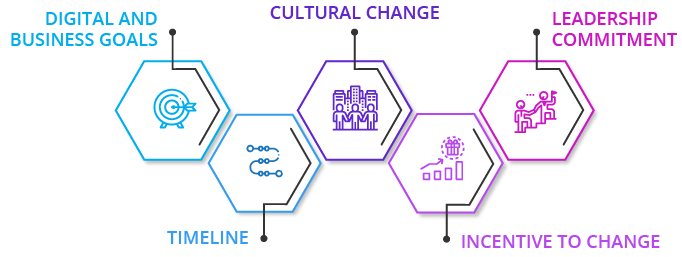
Measure Outcomes and Improvise
As the most crucial element of our DX framework, we have created a simple guideline for companies to measure the outcomes of their DX efforts.
-
What percentage of digital goals has been met?
-
What percentage of the business goals, for which digital initiatives were initiated, have been met?
-
What is the percentage of delay in achieving DX?
-
How successful have the training programs been in triggering the cultural shift?
-
Was the cultural shift properly incentivized?
-
Is the leadership team satisfied with the level of commitment they have shown in ensuring DX success?
Frequent reviews and discussions on these questions shall help faster course corrections and will ensure the success of the final outcome.
Success Story – Luminous Power Technologies Pvt. Ltd.

Rajiv Ganju is the Sr. Vice President, Global Supply Chain at Luminous Power Technologies (P) Ltd. (part of schneider). He was the winner of the IDC Digital Transformer of the year award, 2017.
Rajiv has been intimately involved in the planning, execution, and leadership of Luminous’s massive digital transformation. He spoke at length with Techment Technology and shared the details of their amazing and highly successful transformation. Here is their story!
It is an axiom in the world of DX that lengthier transformations are highly likely to fail, and that makes the transformation of Luminous, an incredibly intriguing success story.
Their transformation is a perfect example of how clear vision, leadership, as well as meticulous planning, can result in a successful DX at scale. In an interview with Techment Technology, Rajiv Ganju spoke about their entire journey. Here are the excerpts from the interview:
Luminous has personified the adage that DX is a journey.
We began our journey in 2015 and have
successfully transformed,
but our journey continues
with more ambitious plans for 2021 and beyond.
-Rajiv Ganju
Rajiv articulated their 3 phase journey:
-
We began with the effort to polarize the culture to a pro-technology mindset.
The journey began with digitization and was our focus for the initial 4 years, 2015- 2018. -
The second phase involved digitalization of the systems and processes in the next 2 years, 2019-20.
-
The third phase that Luminous is going to execute is about the creation of a smart factory that would here to be standard so industry 4.0. It would be pursued from 2021.
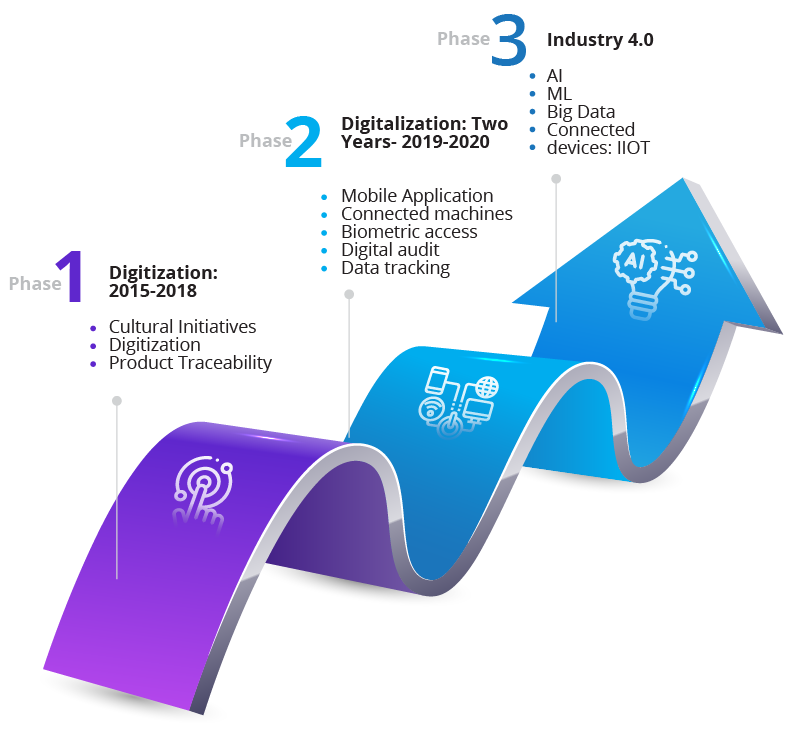
3 Phase Journey of Digitization
Phase 1: Digitization: 2015-2018
-
Cultural Initiatives Led the Transformation
-
Digitization of core operations
Digitization efforts focused on Product Traceability to ensure complete visibility of the entire manufacturing process. It has two parts:
-
Part 1: Focused on serialization of subcomponents and linking them with PCB, along with linking of XTR with Inverter serial numbers.
-
Part 2: Involved the introduction of the following items:

Phase 2: Digitalization: Two Years- 2019-2020
It involved leveraging the digital for tangible business impact.

Phase 3: 2021-Beyond
AI and IoT enabled Smart Factory
Mr. Ganju tells about their vision- At Luminous,
our vision is to establish our leadership in the
Industry 4.0 ecosystem. We are working towards
the creation of a state-of-the-art smart factory.
Transformation’s Focus Areas:
“At luminous, we always focus on sustainability,
and it comes only with cultural acceptance;
culture is key. When the effort is as radical as
digital adoption and transformation, cultural
polarization is of cardinal importance.
To ensure a pro-change culture, we invested heavily in training and exposure. Our people got exposure to the best factories in the world and were inspired to bring home the new.
One of the vital elements of success is to ensure participation and democratization of the process of transformation. The team that was involved in spearheading the DX had representatives from every department; we made every voice count.
Also, a steady and gradual pace of transformation is more sustainable than leapfrogging. Piecemeal transformation helps ensure the sustainability of
digital adoption, new processes as well as performance
improvements.
Rajiv Ganju's recommendations to SMEs:
-
Begin in-house efforts to improve and innovate. It will highlight the real need of the organization.
-
Culture Must Lead Change. Our people received the exposure they needed in terms of possibilities, and we focused heavily on training to ensure upskilling.
-
Incremental Change is sustainable and thus better. Plan for a transformation that runs in a planned manner with bite-size changes; keep the focus on sustainability.
-
Be Cautious while selecting Automation: It is tempting to rope in high-end automation, but it is not sustainable because the company does not have the proper infrastructure to support it. Be ingenious, give preference to simplified and cheaper options that can last longer and can be maintained in house.
-
Measurement Metric: Quality, Cost, Delivery, as well as Environment. Every change must usher-in positive developments in the areas of Quality, Cost, Delivery, as well as the environment. A digital change that props-up quality but slows down production and costs more might not be a move in the right direction. Sustainability is the real challenge of going digital. The only touchstone is the success on each front of Quality, Cost, Delivery, as well as, environment.
“The future of the Global Supply chain is SMART and Tailored supply chains that require SMART People, SMART process, and SMART Infrastructure. Moreover, companies have to be ready for flexibility and tailored supply chains to dream of ATMANIRBHAR (self reliant) Bharat.
To achieve it, Digitization is the cornerstone that will empower companies with predictive, prescriptive, and cognitive mechanisms that address real-time issues and be best in QCD (Quality, Cost, and Delivery).”
Conclusion
A digital transformation is about balancing diverse business and technology elements simultaneously. The process is fraught with numerous challenges for SMEs. Resource crunch, budgetary constraints, time shortages, talent scarcity, and cultural resistance often lead to complications. Experts suggest a piecemeal approach that allows for incremental and marginal transformations as the best way forward. Assessment of digital maturity and refinement of digital vision are the crucial initial steps. The key, they say, is neither to overinvest and nor to underinvest and map each digitization effort back to the business goal.
Shorter sprints with iterative outcome measurement can prop-up success rates by helping leaders and managers stay objective.
In the long run, companies must balance the dual digital imperatives, i.e., striking a balance between building new business models and digitizing or upgrading the legacy operations will help companies grow sustainably.
We hope that this guide contributes to your great migration, and we wish you success and welcome you to the digital age.
About Us
Techment Technology is a Digital Catalyst that catalyzes solution development with its high-velocity agile delivery model.
Our team consists of passionate techno-functional experts that bring an outside-in approach and work as an extension of client’s team. We are industry agnostic and work with global organizations of all sizes, including disruptive startups.
End Notes
- IDC report- IDC FutureScape: Worldwide Digital Transformation 2020 Predictions
- Digital transformers in the pandemic, Susanna Myrtle Lazarus, The Hindu, July 2020
- We Teach Digital Skills at PwC, Mike Fenlon and Sarah McEneaney, HBR, 2018
- Unlocking success in digital transformations, McKinsey survey, 2018





